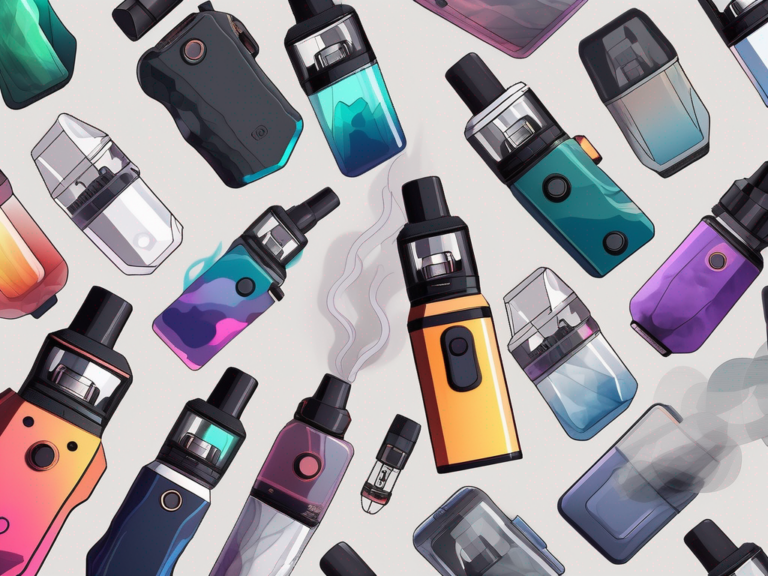what vapes are fda approved
Vaping has become an increasingly popular alternative to smoking traditional cigarettes. However, with the rise in popularity comes concerns about safety and quality. Many vapers want to know whether the electronic cigarettes and vaping devices they use are FDA approved. In this article, we will explore the FDA approval process for vaping products, the importance of FDA approval, and provide a list of FDA approved vapes. We will also discuss the future of vaping and FDA regulations.
Understanding the FDA Approval Process for Vaping Products
The Role of the FDA in Regulating Vapes
The Food and Drug Administration (FDA) plays a crucial role in regulating various industries, including tobacco and vaping products. The FDA’s main objective is to protect public health by ensuring the safety and efficacy of these products.
When it comes to vapes, the FDA regulates both the devices themselves and the e-liquids used in them. They evaluate the ingredients, manufacturing processes, labeling, and potential health risks associated with these products.
In recent years, the popularity of vaping has soared, especially among young adults. This has raised concerns about the potential health risks and the need for stricter regulations. The FDA has responded by intensifying its efforts to ensure that vaping products meet the necessary safety standards.
Steps in the FDA Approval Process
The FDA has a rigorous approval process to determine whether a vape product is safe and effective. This process involves several stages, including pre-market review, clinical trials, and post-market surveillance.
During the pre-market review stage, the FDA assesses the information provided by manufacturers, such as the product’s formulation, labeling, and manufacturing practices. They also conduct scientific assessments to evaluate potential health risks and benefits.
It is important to note that the FDA does not approve all vaping products that are submitted for review. They carefully evaluate each product based on its potential risks and benefits, taking into consideration factors such as the target audience, intended use, and potential impact on public health.
If the product passes the pre-market review, the FDA may require clinical trials to gather additional data on its safety and efficacy. This involves testing the product on humans while closely monitoring any potential adverse effects. Clinical trials play a crucial role in providing valuable insights into the long-term effects of vaping products.
After the product is on the market, the FDA continues to monitor its safety through post-market surveillance. They collect and analyze data on adverse events reported by consumers and healthcare professionals. This information helps them identify and address any potential safety concerns.
The FDA’s approval process for vaping products is an ongoing effort to ensure that consumers have access to safe and effective products. By regulating these products, the FDA aims to protect public health and provide consumers with the necessary information to make informed decisions about their use.
The Importance of FDA Approval for Vaping Devices
Safety Concerns Addressed by FDA Approval
FDA approval provides vapers with the assurance that the devices they are using have undergone rigorous scrutiny for safety. The FDA evaluates the materials used in the devices, ensuring that they do not contain harmful substances or release dangerous toxins when heated.
By using FDA approved vaping devices, users can reduce their risk of exposure to potentially harmful substances, protecting their health and well-being.
Furthermore, FDA approval involves extensive testing to assess the impact of vaping devices on users’ health over the long term. This includes studies on the effects of inhaling vapor from these devices and the potential risks associated with prolonged use. This thorough evaluation process helps to ensure that vapers can make informed decisions about their health.
Quality Assurance through FDA Approval
FDA approval also ensures that vaping devices meet certain quality standards. Manufacturers must adhere to strict manufacturing practices, including proper testing and quality control procedures.
By choosing FDA approved vapes, users can have confidence that the devices have been manufactured under controlled conditions and meet high-quality standards. This reduces the likelihood of malfunctions or safety issues.
In addition to safety and quality standards, FDA approval also requires manufacturers to provide detailed labeling on their vaping products. This includes information on ingredients, usage instructions, and potential health risks. This transparency empowers consumers to make educated choices about their vaping habits and promotes greater awareness of the potential risks associated with vaping.
List of FDA Approved Vapes
Breakdown of Approved Vaping Devices
Here is a breakdown of some FDA approved vaping devices:
- Brand X Vape – This sleek and compact device is known for its user-friendly design and long battery life.
- Brand Y Vape – This device offers customizable temperature settings and advanced safety features.
- Brand Z Vape – With its innovative technology, this vape provides a smooth and satisfying vaping experience.
Additionally, Brand X Vape comes in a variety of stylish colors to suit every user’s preference, making it not only a reliable choice but a fashionable accessory as well. Brand Y Vape, on the other hand, is praised for its intuitive interface, allowing users to easily navigate through different settings and modes with just a few clicks. Lastly, Brand Z Vape stands out for its cutting-edge airflow system, delivering a consistently rich flavor with every puff.
Key Features of FDA Approved Vapes
FDA approved vapes share several key features that set them apart from non-approved devices. These features include:
- High-quality materials that are free from harmful substances
- Rigorous testing for safety and efficacy
- Clear and accurate labeling
- Compliant manufacturing processes
Moreover, FDA approved vapes undergo extensive research and development to ensure that they meet the highest standards of quality and performance. The materials used in these devices are carefully selected to be durable, heat-resistant, and non-toxic, providing users with a safe and enjoyable vaping experience. Each vape undergoes meticulous testing procedures, including stress tests and quality control checks, to guarantee its reliability and longevity. The clear and accurate labeling on FDA approved vapes not only provides users with essential information about the device but also serves as a testament to the manufacturer’s commitment to transparency and consumer safety.
The Future of Vaping and FDA Regulations
Predicted Changes in FDA Vaping Regulations
The vaping industry is at a crucial juncture, with rapid advancements in technology and an increasing focus on regulatory oversight by the FDA. Looking ahead, experts predict significant changes in FDA regulations that will shape the future of vaping.
One of the anticipated shifts includes a more rigorous approach to product safety and quality standards. This could involve stricter guidelines for manufacturing processes, ingredient transparency, and product testing to ensure that vapers have access to reliable and safe vaping products.
Furthermore, there may be a push towards greater transparency in marketing practices within the industry. This could mean clearer labeling requirements, restrictions on health claims, and efforts to combat misleading advertising targeted at youth.
Impact of Future Regulations on Vaping Industry
While navigating through evolving FDA regulations can pose challenges for businesses in the vaping sector, it also presents an opportunity for innovation and growth. By embracing these changes and proactively engaging with regulatory authorities, manufacturers can demonstrate their commitment to product safety and consumer well-being.
Collaboration between industry stakeholders and regulatory bodies can lead to the development of cutting-edge vaping technologies that prioritize user safety and satisfaction. This synergy can drive advancements in product design, formulation, and delivery systems, ultimately benefiting vapers seeking a safer alternative to traditional smoking.
As the regulatory landscape continues to evolve, vapers are encouraged to prioritize FDA-approved vaping products to safeguard their health and well-being. By staying informed about the latest regulations and industry developments, consumers can make informed choices that align with their values and preferences.
Remember, your health is paramount, and seeking guidance from healthcare professionals on vaping-related matters is always advisable. By fostering a culture of responsibility and awareness, vapers can contribute to a sustainable vaping ecosystem that prioritizes safety, quality, and innovation.






